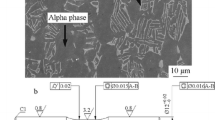Abstract
Most aero-engine components and structures are subjected to life critical fatigue loads during service. Near-α titanium alloy IMI 834 is one candidate aero-engine material that is used as high-pressure compressor discs due to its superior fatigue strength and creep resistance. The effect of heat treatment on the microstructure and high-cycle fatigue behaviour of the material has been studied and reported here. The alloy was solution-heat-treated at 1060 °C and subsequently quenched in different media. A strong effect of quench media (cooling rate) on high-cycle fatigue life has been observed. Fractographic investigations were performed to correlate the fracture micro-mechanism with heat treatment. Further, a generalized stress-life model has been deduced from the fatigue data and integrated with finite element analysis to develop a fatigue model for the alloy.








Similar content being viewed by others
References
Lütjering G, Williams J C, and Gysler A, in Microstructure and Properties of Materials (2000), vol. 2, pp. 1–77.
Bania P J, Hutt A J, and Adams R E, in Beta Titanium Alloys in the 1990’s (1993).
Welsch G, Boyer R, and Collings E W (eds) Materials Properties Handbook: Titanium Alloys, ASM International, Cleveland (1993).
Cowles B A, Int J Fract 80 (1996) 147.
Peters M, Lütjering G, and Ziegler G, Zeitschrift für Metallkunde 74 (1983), 274.
Du Z, Xiao S, Xu L, Tian J, Kong F, and Chen Y, Mater Des 55 (2014) 183.
Neal D F, in Titanium Science and Technology, (eds) Lutjering G, Zwicker U, and Ansd Bunk W, DGM, Oberursel Germany (1985), vol. 4, pp. 2419–2424.
Sha W, and Malinov S, Titanium Alloys: Modelling of Microstructure, Properties and Applications, Elsevier, Amsterdam (2009).
Wu G Q, Shi C L, Sha W, Sha A X, and Jiang H R, Mater Des 46 (2013) 668.
Ivanova S G, Biederman R R, and Sisson R D, J Mater Eng Perform 11 (2002) 226.
Zuo J H, Wang Z G, and Han E H, Mater Sci Eng A 473 (2008) pp.147.
Lütjering G, and Williams J C, Titanium. Springer, Berlin (2007).
Wagner L and Lütjering G, in Titanium, Science and Technology, Les Editions de Physique (1988) p. 345.
Ivanova S G, Cohen F S, Biederman R R, and Sisson Jr R D, Role of Microstructure in the Mean Stress Dependence of Fatigue Strength in Ti–6Al–4V alloy, Worcester Polytechnic Institute, Worcester (1999).
Peters M, Gysler A, Lütjering G. in Titanium’80 Science and Technology (eds) Kimura H and Izumi O, AIME, New York (1980), pp. 1777–1786.
Wu Z, Kou H, Tang L, Chen W, Han X, Deng Y, Tang B, and Li J, Eng Fract Mech 235 (2020) 107129.
Singh N, and Singh V, Mater Sci Eng A 325 (2002) 324.
Hardt S, Maier HJ, and Christ HJ, Int J Fatigue 21 (1999) 779.
Golden P J, John R, and Porter III W J, Procedia Eng 2 (2010) 1839.
Furuya Y, and Takeuchi E, Mater Sci Eng A 598 (2014) 135.
Neal D F, and Blenkinsop P A, Acta Metallurgica 24 (1976) 59.
Ramanujan R V, and Maziasz P J, Metall Mater Trans A 27 (1996) 1661.
Bywater K A, and Christian J W, Philos Mag 25 (1972) 1249.
Balasundar I, Raghu T, and Kashyap B P, Mater Perform Charact 8 (2019) 932.
Semiatin S L, Metall Mater Trans A (2020) 1–33.
Lucas J J, in Titanium Science and Technology (eds) Jaffee R I and Burte H M, Plenum Press, New York, NY (1973), vol. 3, pp. 2081–2095.
Nalla R K, Ritchie R O, Boyce B L, Campbell J P, and Peters J O, Metall Mater Trans A 33 (2002) 899.
Brown C W, and Hicks M A, Fatigue Fract Eng Mater Struct 6 (1983) 67.
Wang Q Y, Bathias C, Kawagoishi N, and Chen Q, Int J Fatigue 24 (2002) 1269.
Xue H, Gao T, Sun Z, and Zhang X, in MATEC Web of Conferences, EDP Sciences (2018), vol. 165, p. 20003.
Yadav V K, Gaur V, and Singh I V, Mater Sci Eng A 779 (2020) 139116.
Kondo Y, Sakae C, Kubota M, and Kudou T, Fatigue Fract Eng Mater Struct 26 (2003) 675.
Peters J O, and Lütjering G, Metall Mater Trans A 32 (2001) 2805.
Sinha V, Mills M J, Williams J C, and Spowart J E, Metall Mater Trans A, 37 (2006) 1507.
Basquin O H, in Proc Am Soc Test Mater (1910), vol. 10, pp. 625–630.
Stephens R I, Fatemi A, Stephens R R, and Fuchs H O, Metal Fatigue in Engineering, Wiley, New York (2001).
Ellyin F, in Fatigue Damage, Crack Growth and Life Prediction. Springer, Dordrecht (1997), pp. 145–178.
Meyers M A, and Chawla K K, Mechanical Behavior of Materials, Cambridge University Press, Cambridge (2008).
Morrow J, in Internal Friction, Damping, and Cyclic Plasticity. ASTM International (1965).
Naglakshmi G, and Kumar V, High temperature fatigue crack growth behavior of IMI 834 Ti alloy, DMRL Technical Report No. 371 (2005).
Acknowledgements
The constant support and encouragement from Dr. G. Madhusudan Reddy, Director and Dr. T. K. Nandy, Associate Director, DMRL, is gratefully acknowledged. Technical discussions on Ti alloys with Dr. S. Banumathy, DMRL, are also acknowledged. Mr. S. Ahmad, DMRL and his team is acknowledged for timely availability of fatigue specimens for testing. Thanks are also due to Dr. Vikas Kumar (Former Director, DMRL) and Dr. D.V.V. Satyanarayana, Sc ‘G’, Head, Mechanical Behaviour Group, DMRL, for their guidance and support in executing this study. The authors would also like to thank DRDO, India, for funding this research.
Author information
Authors and Affiliations
Corresponding author
Additional information
Publisher's Note
Springer Nature remains neutral with regard to jurisdictional claims in published maps and institutional affiliations.
Appendix: MATLAB Code
Appendix: MATLAB Code

Rights and permissions
About this article
Cite this article
Bhandari, L., Kumar, J., Balasundar, I. et al. Variability in Fatigue Life of Near-α Titanium Alloy IMI 834. Trans Indian Inst Met 74, 979–989 (2021). https://doi.org/10.1007/s12666-021-02210-z
Received:
Accepted:
Published:
Issue Date:
DOI: https://doi.org/10.1007/s12666-021-02210-z




